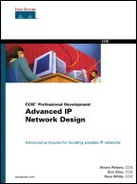Case Study: Summarization Methods
There are two basic tools used to summarize routes in EIGRP: summary-address statements and distribute-list statements. These two methods provide significantly different approaches to limiting the routing updates to a summary of the information and each is uniquely useful. The best solution to a summarization problem is often a mixture of both approaches. One or both of these basic tools will be applied in all three layers—core, distribution, and access—in order to provide the maximum in summarization and, thus, the maximum in stability and scalability. Next, you can look at each tool in order to understand the pros and cons of each.
summary-address Statements
The first summarization tool is the summary-address statement. This command is in the form ip summary-address eigrp AS network mask distance and is applied to an interface of a Cisco router out of which you want to advertise a summary route. The summary-address command provides two related functions:
It creates a summary route in the routing table (identified as a summary route with a next-hop address of null0). It will then propagate to any neighbors out of the interface with the summary address statement defined.
It filters out the components of the summary that would normally have been sent out of the interface with the summary address statement. In this way, it sends ONLY the summary information.
While the summary address method of summarization is extremely flexible and powerful, it can also be administratively wearisome and possibly error-prone. As mentioned previously, the summary-address statement needs to be applied to each interface that you want to advertise the summary. On routers that contain dozens or even hundreds of interfaces and subinterfaces, there can be a large number of summary-address statements that must be defined correctly.
There are also a couple of issues that need to be understood about the summary address implementation in order to make proper use of the tool. First, a summary route will be created and sent only if EIGRP has an internal component of the summary. This means that if all components that make up the summary disappear, or only external (redistributed) components exist, the summary route is not installed and advertised. This is proper behavior because a router should not be advertising that it can reach a range of addresses if there are not any components of that range reachable through the advertising router.
One unfortunate side-effect of using the summary address method is that if you are receiving a route that matches the summary (same network and mask) from another source, you won't accept it. This is because the summary route generated by the summary-address command has an administrative distance of five by default, which will be better than the administrative distance of any dynamically learned route.
To illustrate, suppose that you have a router that is learning its default route through an external source:
router#show ip route
….
Gateway of last resort is 172.19.1.1 to network 0.0.0.0
….
D*EX 0.0.0.0/0 [170/2195456] via 172.19.1.1, 00:00:09, Serial0
You want to configure a summary-address statement that will advertise the least number of routes possible out of interface serial 1. So, you will configure the following:
router(config)#int serial 1
router(config-if)#ip summary-address eigrp 100 0.0.0.0 0.0.0.0
Now, you have:
rp-2501-13a#show ip route
….
Gateway of last resort is 0.0.0.0 to network 0.0.0.0
….
D* 0.0.0.0/0 is a summary, 00:00:49, Null0
This is a problem. Any packets that should follow the default route and be directed toward 172.19.1.1 will actually be sent to null0 (the bit-bucket). Essentially, you will throw these packets away.
To resolve this, you can use a new addition on the ip summary-address command:
router(config-if)#ip summary-address eigrp 100 0.0.0.0 0.0.0.0 200
The final 200 sets the administrative distance of this summary route to 200. Although the downstream router will still receive only the 0.0.0.0/0 route, the summary won't be installed in this router's routing table because the administrative distance is higher than the external EIGRP route you currently have. This feature isn't available in all versions of IOS software. (It was integrated in 12.0(5)T, so the version must be later than this.)
distribute-list Statements
The second method used to filter and summarize routes in EIGRP is to define distribute lists under the EIGRP configuration. This method uses a totally different approach than the summary-address statements, but it provides very similar functionality. With the distribute list approach, you explicitly tell EIGRP which routes are allowed to be advertised out of any or all interfaces. The command is of the form distribute-list {access-list-number|name} out [interface-name|routing-process] and is entered in EIGRP configuration mode. The access list associated with the distribute list (access list 1 in the example) describes the route, or routes, that can be sent out the interface defined under the distribute-list command. A wildcard mask can be supplied in the access list in order to have more than one route permitted under the same access list.
Note that a key difference between distribute lists and summary addresses is that distribute lists do not automatically create the summary route you need to advertise. If the route permitted by the access list does not exist, then the route is not sent, of course. Typically, the network manager will define a static route to match the access list so that the route will always be there to advertise. This static route can be floating (that is, with a high administrative distance) so that if the same route is learned from elsewhere, it will be accepted and used. The static route will be used only if the dynamically derived route disappears.
